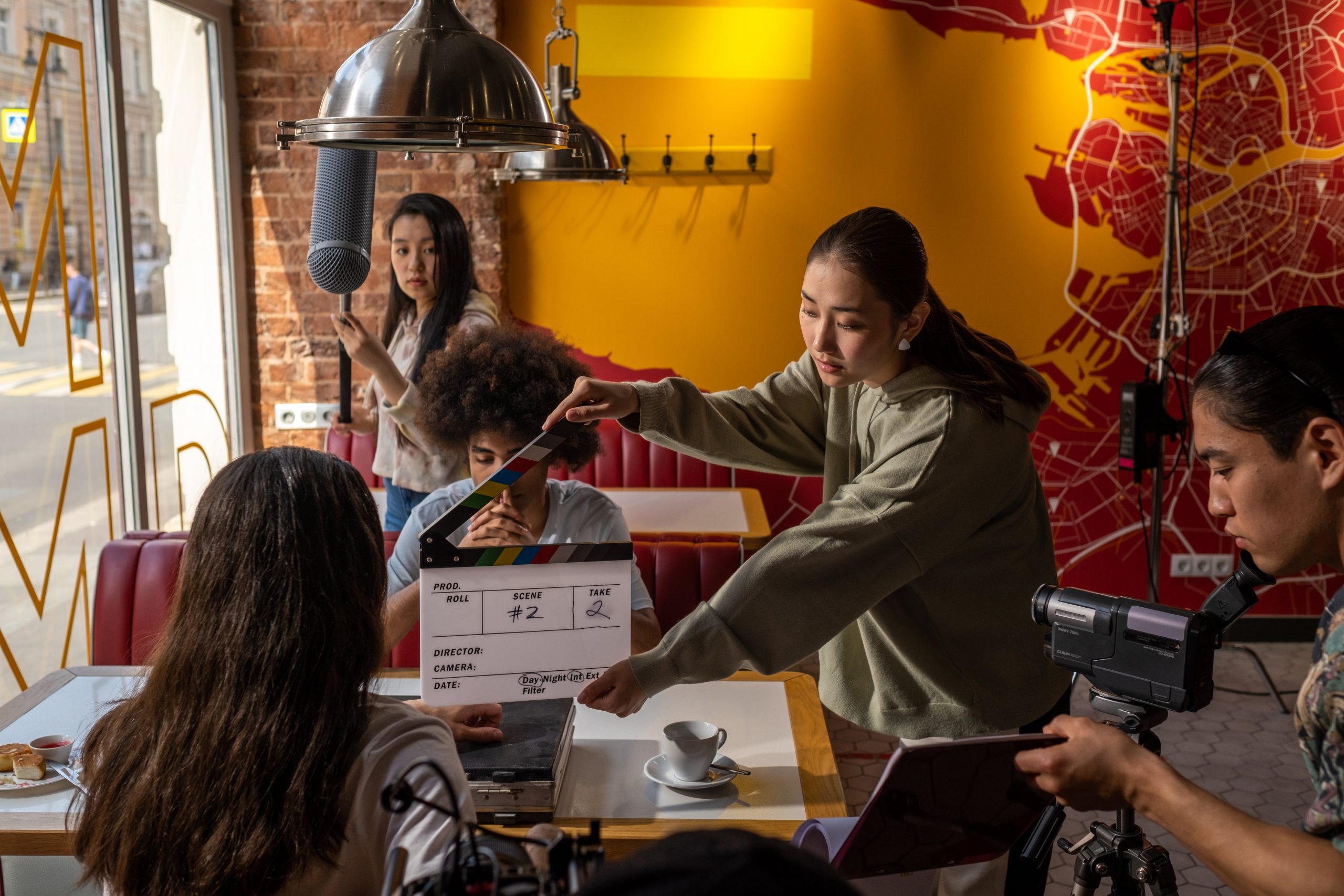Are you looking to create a video project or entrust its production to a video agency, and want to understand the audiovisual production process? You are in the right place. At Digital Video, we handle everything from the idea to its distribution. In this article, we explain the key steps in video production.
Table of Contents:
- Pre-production: From Concept to Filming
- Video Production: Live Action, Reporting, and Animation
- Post-production: From Creativity to Deliverable
Pre-production: From Concept to Filming
Although a multitude of steps govern video production, it is generally divided into three main stages: pre-production, production (filming), and post-production. Whether it’s a fiction film, a corporate film, a report, a web series, or any other project, all video production begins at the beginning: the idea.
The Concept in Video Production
Regardless of your role in video production, a few questions may be useful in defining your concept: What is my objective? What message should the deliverable convey? Who is the target audience? Here are some points to consider before producing your video:
- Define clear objectives. Be as specific as possible. You might already have an idea of the desired length, the call to action that this video should produce, or the key features to highlight. Do not hesitate to specify these elements if you are working with an agency.
- Identify the target audience. What audience do you want to reach with your video? Understanding your audience will help you adapt the content of the video to make it more effective.
- Determine the key message. Determine the message you want to communicate. What information or feeling do you want viewers to retain after watching the video?

The Script and Technical Breakdown
Once the idea is found, it must be translated into a script. The script adheres to specific codes, understandable by all members of a production team. It can be complemented by an intention note and a synopsis.
The person in charge of the film then generally undertakes the first version of a technical breakdown. Although it can take several forms, it describes what happens in terms of image and sound in a film. It includes the shots that break down each sequence, the duration of each shot, and the connections between them.
The technical breakdown can be accompanied by a storyboard. These two documents are reviewed jointly with the script supervisor and the director of photography (the person in charge of the film’s imagery).
Human and Technical Pre-production
The project is now on track to move to the next phase of video pre-production: mobilizing human and technical resources. Here, the person in charge of production budgets, seeks funding, and researches.
In parallel, the team is formed. Assistant direction, production, script supervision, image team, sound team: all the necessary people for video production are recruited and begin working on the project.
They search for the necessary shooting locations, hold castings in the case of a live-action fiction video production, and look for the necessary filming equipment. In the case of an agency such as Digital Video, this last point is done internally since all the technical equipment is already available in our premises.
Logistical planning also takes place at this stage, and nothing can be left to chance. Rehearsals and meetings cover all the essential points of the shoot, which is meticulously organized. The actors and director rehearse, and the assistant director sends a route sheet to the rest of the team.

Video Production: Live Action, Reporting, and Animation
The budget is confirmed and the deliverable schedule as well. The script is written, the technical breakdown finalized and reviewed with the script supervisor and director of photography. The entire creative team is ready: the visual and sound atmospheres have been defined in advance, the sets have been built if necessary. The production itself, whether it’s shooting or animation, marks the transition of your idea into reality.
Live Action Fiction Shooting
Live-action shooting is perhaps the most traditional form of video production, involving real actors, tangible sets, and a dedicated team to capture the scene. In the case of a fiction video production (whether it’s an advertisement or another format), the actors and director have done their rehearsals. The production management, makeup, and costume teams are ready, as are the technical teams. All that’s left is to shoot! Here are some essential elements of filming:
- Actor Direction. The performance of the actors is crucial to bringing the script to life. The director works closely with the actors to ensure that the emotions, dialogues, and actions match the defined vision.
- Framing and Composition. Alongside the director, the director of photography is responsible for the composition of the shots. This involves choosing camera angles, deciding how actors will be framed, and creating the visual staging of each shot.
- Audio Capture. In addition to the image, audio is essential. A sound engineer ensures that the sound is recorded clearly and without unwanted noise. This may involve the use of directional microphones and high-quality audio equipment.

Corporate Films: Reporting
The shooting of a report differs from the production of narrative or advertising videos. From capturing a specific event to visually presenting a brand, to highlighting an activity or achievements, the work beforehand remains essential to maintain consistency with the overall communication strategy.
Once the teams, sets, and technical equipment are in place, every detail is worked to ensure the best possible image and sound quality. If necessary, the people interviewed rehearse to get used to the environment and instructions, allowing the team to make the final technical adjustments. When it comes time to shoot, several takes may be necessary for each scene, to provide the post-production team with multiple choices of shots.
In the case of video capture, the team must be quick and responsive. They favor mobile equipment to follow the essential elements of an event as they unfold, i.e., live.
Video Production in Animation
A distant cousin of traditional video production, animated video production follows a process of its own. It includes:
- Character and Set Design. Characters and sets are created in 2D or 3D. This step includes designing models, textures, and visuals.
- An Animated Storyboard. An animated storyboard is often used to plan the animation sequence, to define the movements and expressions of the characters.
- The characters come to life through facial and body movements, or expressions.
- Lighting and Rendering. Just like traditional shoots, lighting is set for each scene.
- Special Effects. Any special effects are added to the video.
- Sound and Music. Sound design, sound effects, music, and voice-overs are then added and bring the film to life.
Post-production: From Creativity to Deliverable
The images are in the box, and your video production is coming to an end. But before that, there’s one last step: video post-production. This step includes image and sound editing, mixing, color grading, and, if applicable, composing music or creating special effects.

The Creative Process of Video Post-production
Depending on the project, this creative phase can take several forms, but it generally starts with the selection of shots to keep in the final video. Once this is done, the film’s shots are assembled, and sound and image are synced. It is said that a film is written three times: during the development of the script, during shooting, and during editing. Many creative choices are made during this stage. Once this is finalized, all that remains is to edit and mix the sound elements.
The film is almost ready; all that remains is color grading, the last phase of video post-production. This involves color correction, which allows harmonizing the image of your video production.
Deliverables and Distribution
The video production has ended, and you finally have the finished product in front of you. All that remains is to distribute the film on your preferred channels. Is it a report for social media, an animation for your website, a film for an internal presentation, or an advertisement? The distribution strategy is essential to the process. It includes choosing distribution platforms, planning publication dates, defining target audiences and objectives.
Each distribution platform has its own specificities in terms of format, resolution, and recommendation algorithm. To improve visibility and engagement, make sure your content is optimized for each platform, or collaborate with an agency that will accompany you in this process.
Don’t forget to measure the impact of the video once distributed. Stakeholder feedback, the number of online views, the engagement rate, return on investment, and other indicators should allow you to measure the effectiveness of your campaign.
You can then adjust your video content based on these metrics to ensure an effective and lively production.
Choosing the Right Video Production Agency
You now understand the workings of video production, from concept to realization. It is crucial to choose the right agency to accompany you throughout this process. Corporate film, advertisement, capture, report, animation… Whatever your project, define your needs and objectives in advance. Then consult the portfolios of different agencies, and read the testimonials.
To choose your agency, a few criteria are essential. Creativity, the efficiency of processes, the equipment available, transparency in pricing, and deadlines and responsiveness are all factors that should influence your decision.
The most important thing is the chemistry with the agency! A positive relationship guarantees effective collaboration.
At Digital Video, we offer all this, and more.
Do you want to turn your vision into a video? Contact us. From scriptwriting, production to distribution, Digital Video accompanies you at all stages of your film’s realization.



